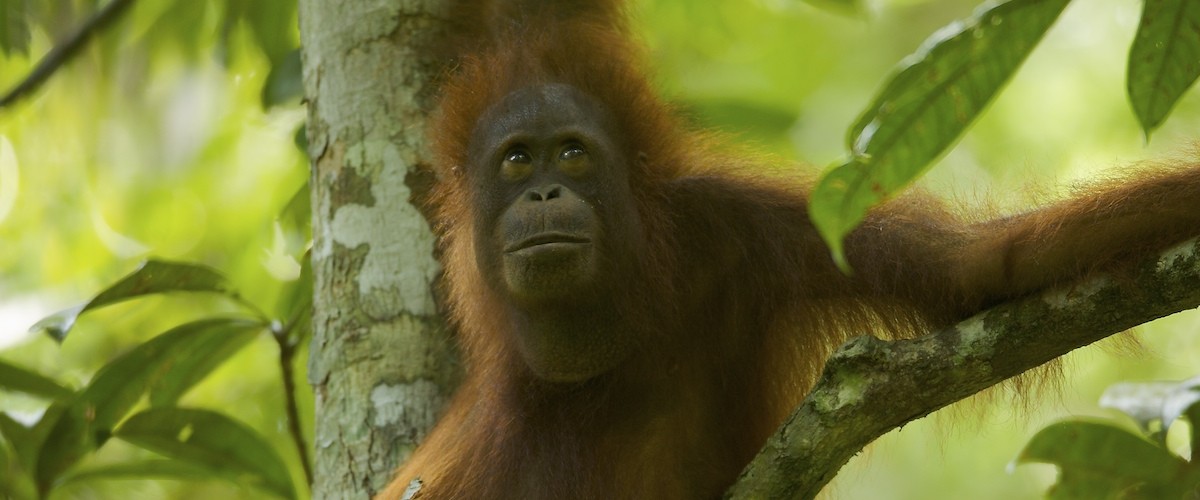By Dr. Erin Kane, GPOCP Post-Doc Researcher
When I sat down on the third of five planes taking me from Boston to the Bornean rainforest, the lady sitting next to me smiled and started making small talk. “I’m visiting family in Jakarta! And what brings you to Indonesia?” I gave her the short and easy answer – “Orangutans!” – but took a moment to reflect on the path that got me to this window seat.
I was in seventh grade pouring over the shelves at the public library, when my dad handed me a well-worn hardback copy of Jane Goodall’s book, In the Shadow of Man. In that, Jane Goodall writes about her journey from mild-mannered English schoolgirl to groundbreaking chimpanzee researcher working in Tanzania. I decided that that was what I was going to be when I grew up! Enthusiastic science teachers in middle school and high school supported my goals, thrilled to know that there was a 13-year-old girl who saw herself as a professional scientist. My parents didn’t balk either when I went off to college in St. Louis with a plan to study primates.
 |
|
Sunset over the Los Amigos River in Peru, where Erin first studied wild primates.
|
As soon as I completed my BA, I volunteered as a research assistant on a project examining the genetics and behavior of saddle-back tamarins in the rainforest of southeastern Peru. Waking up every morning to follow small groups of 300 gram monkeys and recording exactly how they cared for their twins was amazing. The forest was literally teeming with monkeys – every day, I’d see five or six different species – and an occasional tapir, ocelot, and armadillo sighting more than made up for bullet ants and botflies. Satisfied that the rainforest really was where I wanted to be, I accepted a position in The Ohio State University’s anthropology graduate program.
 |
|
Veronique, an adult female Diana monkey, shows off the species’ beautiful coloration in Taï National Park.
|
As a graduate student, my research focused on the primate community of Côte d’Ivoire’s Taï National Park. This forest – the largest intact chunk of a rainforest belt that once stretched from Guinea to Benin – became my home for nearly two years while I conducted research for my MA and PhD. Like most forests where primates are found, the Taï Forest experiences relatively predictable shifts in fruit availability during different seasons. This has all sorts of interesting implications for the primates that live there, but I was particularly interested in the ways that adult female Diana monkeys coped with these changes. Diana monkeys are not only highly attractive monkeys, they are also among the most frugivorous and most territorial monkeys in the Taï Forest. Examinations of fecal hormones suggested that Diana monkeys really aren’t ever particularly stressed, despite maintaining a fruit-rich diet year-round. This is possible in part because Diana monkeys are dominant to other monkey species in the forest: they are able to monopolize resources by preventing other monkeys from eating the available food. In addition, they either feed in trees large enough for the whole group to eat in at once, or they forage in small, but very abundant, trees. They buffer themselves against negative consequences of low fruit availability by timing energetically expensive periods of reproduction (like nursing) to occur when fruit is most abundant in their forests.
 |
|
Erin and Frederic Gnepa, her primary research assistant in Taï National Park, Côte d’Ivoire
Photo credits Erin Kane.
|
My dissertation work showed some of the ways primates can adapt to predictable fluctuations in food availability, but I was curious about how other primates cope with these challenges. Orangutans live in forests that fruit unpredictably, which offers yet another wrinkle in their quest to grow, develop, reproduce, and persist. As a post-doctoral researcher, I hope to understand the ways that ecological uncertainty has shaped orangutans’ long juvenile periods and slow reproduction. I’m thrilled to finally be on my way to Cabang Panti Research Station in Gunung Palung National Park!






